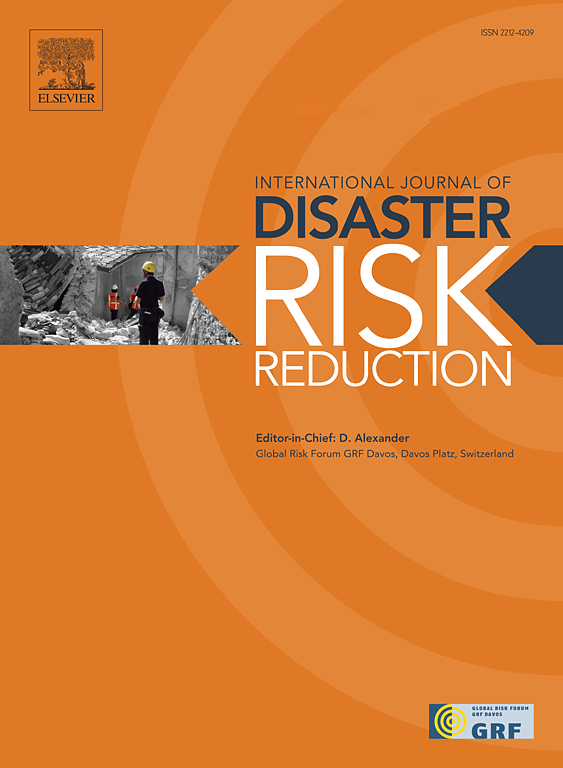使用基于代理的建模和基于计算机视觉的损害评估的龙卷风影响社区的复原力分析和公平恢复框架
IF 4.2
1区 地球科学
Q1 GEOSCIENCES, MULTIDISCIPLINARY
International journal of disaster risk reduction
Pub Date : 2025-04-15
DOI:10.1016/j.ijdrr.2025.105427
引用次数: 0
摘要
本文提出了一个集成基于智能体的建模(ABM)、遥感和深度学习(DL)的框架来预测龙卷风后情景的长期恢复。该框架考虑了公平恢复的概念,并研究了经济政策对增强社区恢复力的影响。首先,使用DL和遥感龙卷风后图像的计算机视觉技术对建筑物进行快速、即时和准确的损害评估。灾后建筑物损坏评估结果然后用于确定增强藤田(EF)龙卷风图。随后,建筑物的破坏状态(DSs)和EF图作为灾后恢复分析初始条件的输入。利用ABM模拟长期恢复,ABM利用各种损失、恢复和社会经济预测模型。基尼指数估计了不同社会经济群体在恢复过程中的不平等,从而产生了一种新的公平的恢复力衡量方法。因此,该框架能够纳入各种减灾政策,并促进有效恢复和公平社区复原力的决策。该框架应用于2011年乔普林龙卷风的乔普林试验台,以证明其在灾后立即评估和政策制定方面的效率和适用性,以增强社区的复原力。结果表明,与仅依赖于预测风险和脆弱性分析的ABM方法相比,该框架确保了更全面和实用的复原力分析。本文章由计算机程序翻译,如有差异,请以英文原文为准。
A framework for resilience analysis and equitable recovery in tornado-impacted communities using agent-based modeling and computer vision-based damage assessment
This paper proposes a framework integrating agent-based modeling (ABM), remote sensing, and deep learning (DL) to predict long-term recovery in post-tornado scenarios. The concept of equitable recovery is considered in the framework, and the effects of economic policies on enhancing community resilience are investigated. First, computer vision techniques using DL and remote sensing post-tornado images are employed for rapid, immediate, and accurate damage assessment of buildings. The post-disaster building damage assessment results are then used to determine the Enhanced Fujita (EF) tornado map. Subsequently, the damage states (DSs) of buildings and the EF map serve as inputs for the initial conditions of the post-disaster recovery analysis. The long-term recovery is simulated using ABM, which utilizes various loss, recovery, and socioeconomic predictive models. The Gini index estimates the inequality in the recovery processes among different socioeconomic groups, leading to a novel equitable resilience measure. Hence, the framework enables the incorporation of various hazard mitigation policies and facilitates decision-making for efficient restoration and equitable community resilience. The framework is applied to the Joplin testbed, subjected to the 2011 Joplin tornado, to demonstrate its efficiency and suitability for immediate post-disaster assessment and policymaking to enhance community resilience. The results indicate that the proposed framework ensures a more comprehensive and practical resilience analysis than the ABM approach, which relies solely on predictive hazard and fragility analysis.
求助全文
通过发布文献求助,成功后即可免费获取论文全文。
去求助
来源期刊

International journal of disaster risk reduction
GEOSCIENCES, MULTIDISCIPLINARYMETEOROLOGY-METEOROLOGY & ATMOSPHERIC SCIENCES
CiteScore
8.70
自引率
18.00%
发文量
688
审稿时长
79 days
期刊介绍:
The International Journal of Disaster Risk Reduction (IJDRR) is the journal for researchers, policymakers and practitioners across diverse disciplines: earth sciences and their implications; environmental sciences; engineering; urban studies; geography; and the social sciences. IJDRR publishes fundamental and applied research, critical reviews, policy papers and case studies with a particular focus on multi-disciplinary research that aims to reduce the impact of natural, technological, social and intentional disasters. IJDRR stimulates exchange of ideas and knowledge transfer on disaster research, mitigation, adaptation, prevention and risk reduction at all geographical scales: local, national and international.
Key topics:-
-multifaceted disaster and cascading disasters
-the development of disaster risk reduction strategies and techniques
-discussion and development of effective warning and educational systems for risk management at all levels
-disasters associated with climate change
-vulnerability analysis and vulnerability trends
-emerging risks
-resilience against disasters.
The journal particularly encourages papers that approach risk from a multi-disciplinary perspective.
 求助内容:
求助内容: 应助结果提醒方式:
应助结果提醒方式:


